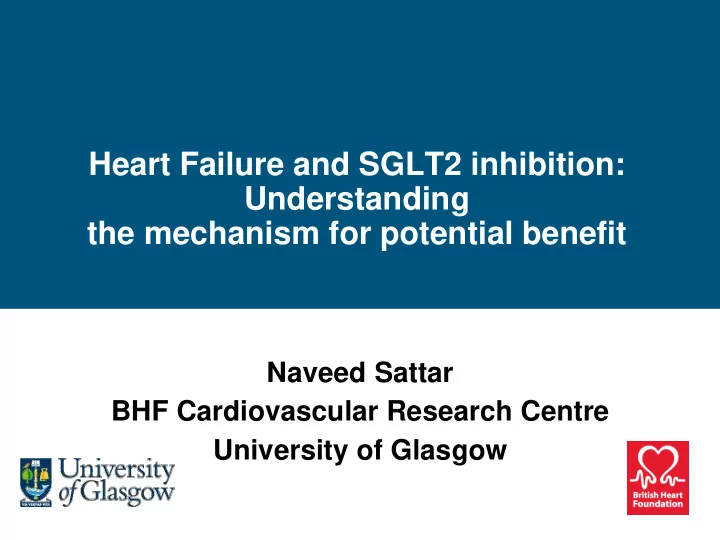

Heart Failure and SGLT2 inhibition: Understanding the mechanism for potential benefit Naveed Sattar BHF Cardiovascular Research Centre University of Glasgow
CV death, MI and stroke Patients with event/analysed Empagliflozin Placebo HR (95% CI) p -value 3-point MACE 490/4687 282/2333 0.86 (0.74, 0.99)* 0.0382 CV death 172/4687 137/2333 0.62 (0.49, 0.77) <0.0001 Non-fatal MI 213/4687 121/2333 0.87 (0.70, 1.09) 0.2189 Non-fatal stroke 150/4687 60/2333 1.24 (0.92, 1.67) 0.1638 0,25 0,50 1,00 2,00 Favours empagliflozin Favours placebo Cox regression analysis. MACE, Major Adverse Cardiovascular Event; HR, hazard ratio; CV, cardiovascular; MI, myocardial infarction *95.02% CI 2
Hospitalisation for heart failure HR 0.65 (95% CI 0.50, 0.85) p =0.0017 Cumulative incidence function. HR, hazard ratio 3
Mechanism of action: thoughts changed Schools of thought Before versus after trial Expectations vs reality Unexpected findings
Empagliflozin modulates several factors related to CV risk Other BP Arterial stiffness Albuminuria Uric acid Sympathetic Glucose nervous system Insulin activity ↑LDL -C ↑HDL -C Weight Triglycerides Visceral adiposity Oxidative stress Adapted from Inzucchi SE,Zinman, B, Wanner, C et al. Diab Vasc Dis Res 2015;12:90-100 5
HbA1c 9,0 Adjusted mean (SE) HbA1c (%) 8,5 Placebo 8,0 Empagliflozin 10 mg Empagliflozin 25 mg 7,5 7,0 6,5 6,0 0 12 28 40 52 66 80 94 108 122 136 150 164 178 192 206 Week Placebo 2294 2272 2188 2133 2113 2063 2008 1967 1741 1456 1241 1109 962 705 420 151 Empagliflozin 10 mg 2296 2272 2218 2150 2155 2108 2072 2058 1805 1520 1297 1164 1006 749 488 170 Empagliflozin 25 mg 2296 2212 2150 2080 1842 1190 498 2280 2152 2115 2044 1540 1327 1043 795 195 All patients (including those who discontinued study drug or initiated new therapies) were included in this mixed model repeated measures analysis (intent-to-treat) X-axis: timepoints with reasonable amount of data available for pre-scheduled measurements 6
Post trial – Not athero-thrombotic Too fast HFH CVD death BUT not MI or CVA suggests: – vascular actions so cardiac pre- and after-load – renal actions leading to extracellular fluid volume and cardiac pre-load – cardiac metabolism better? enhancing diastolic and systolic function
Cherney et al (2014) Circulation
1 2 KIDNEY: SGLT2 inhibition CIRCULATION Urinary glucose loss Intravascular /ECF glucose and sodium Urinary sodium loss volume reabsorption in proximal + Diuresis Haematocrit tubule (+ calorie loss, weight (thus, haemoconcentration) reduction?) Systolic blood pressure (improved tubular glomerular feedback) 3 Improved renal function HEART (+Lungs) Cardiac afterload Cardiac pre-load Myocardial oxygen supply +/- Improved cardiac metabolism? 4 Improvement in systolic and diastolic dysfunction Likelihood of pulmonary congestion, Lower risk of HFH Lower risk of fatal arrhythmias Sattar et al (2016) Diabetologia
Sodium homeostasis: tubulo-glomerular feedback Afferent arteriolar Proximal constriction tubular sodium reabsorption Adenosine release Furosemide Increased distal tubular sodium concentration
Cardiac (patho-)physiology
BP reduction is extremely effective in reducing the risk of developing HF
BP reduction is extremely effective in reducing the risk of developing HF Heart failure
How much BP reduction? Mean BP difference 6.3/2.8mmHg
Do only patients with a very high BP benefit? SPRINT EMPA-REG BP 139.7/78.1 mmHg BP 135.5/76.7 mmHg Heart failure – HR 0.62 Heart failure – HR 0.65 (0.45, 0.84); P=0.002 (0.50, 0.85); P=0.002
Are diabetes patients at elevated HF / fatal MI risk? ERFC (2010) Lancet Hazard ratios for vascular outcomes DM vs. no DM
Paradigm: many reasons for 𝐈𝐆 𝐬𝐣𝐭𝐥 𝐣𝐨 𝐞𝐣𝐛𝐜𝐟𝐮𝐟𝐭 Atherothrombosis Heart failure / CVD death risks emerge over time Smoking Hypertension Dyslipidaemia Renal disease Hypertension Body Obesity Volume Hyperglycaemia changes + some diabetes drugs – Microvascular damage Hyperglycaemia – Myocardial effects CHD
Emerging concept HF & related Non-fatal MI + CVA outcomes Pioglitazone (IRIS) SGLT2 Statins Metformin Inhibitors BP Reduction NB: different weight gain, other risks
Remaining questions More than diuretic effect? – glucose, weight, better renal effect? Likely yes Will other SGLT2 inh. show same? – time will tell but likely yes – trials on the go
Conclusion: Empa haemodynamic / renal benefits in groups at heart failure risk 1 2 KIDNEY: SGLT2 inhibition Urinary glucose loss CIRCULATION glucose and sodium Urinary sodium loss Intravascular /ECF volume reabsorption in proximal + Diuresis Haematocrit (+ calorie loss, weight tubule (thus, haemoconcentration) reduction?) Systolic blood pressure ( Improved tubular glomerular feedback ) 3 Improved renal function HEART (+Lungs) Cardiac afterload Cardiac pre-load Myocardial oxygen supply +/- Improved cardiac metabolism? 4 Improvement in systolic and diastolic dysfunction Likelihood of pulmonary congestion, Lower risk of HFH Sattar et al (2016) Diabetologia Lower risk of fatal arrhythmias
Recommend
More recommend